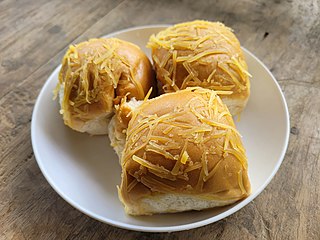
Coconut jam, also known as kaya jam or simply kaya, is a sweet spread made from a base of coconut milk, eggs, sugar and sometimes pandan leaves as a flavouring. It is popular throughout Southeast Asia.

Filipino cuisine is composed of the cuisines of more than a hundred distinct ethnolinguistic groups found throughout the Philippine archipelago. A majority of mainstream Filipino dishes that compose Filipino cuisine are from the food traditions of various ethnolinguistic groups and tribes of the archipelago, including the Ilocano, Pangasinan, Kapampangan, Tagalog, Bicolano, Visayan, Chavacano, and Maranao ethnolinguistic groups. The dishes associated with these groups evolved over the centuries from a largely indigenous base shared with maritime Southeast Asia with varied influences from Chinese, Spanish, and American cuisines, in line with the major waves of influence that had enriched the cultures of the archipelago, and adapted using indigenous ingredients to meet local preferences.

Torta is a culinary term that can, depending on the cuisine, refer to cakes, pies, flatbreads, sandwiches, or omelettes.

A buñuelo (Spanish:[buˈɲwelo], alternatively called boñuelo, bimuelo, birmuelo, bermuelo, bumuelo, burmuelo, or bonuelo, is a fried dough fritter found in Spain, Latin America, and other regions with a historical connection to Spaniards, including Southwest Europe, the Balkans, Anatolia, and other parts of Asia and North Africa. Buñuelos are traditionally prepared at Christmas. It will usually have a filling or a topping. In Mexican cuisine, it is often served with a syrup made with piloncillo.

Siopao, is a Philippine steamed bun with various fillings. It is the indigenized version of the Fujianese baozi, introduced to the Philippines by Hokkien immigrants during the Spanish colonial period. It is a popular snack in the Philippines and is commonly sold by bakeries and restaurants.

Pandesal, also known as Pan de sal is a staple bread roll in the Philippines commonly eaten for breakfast. It is made of flour, yeast, sugar, oil, and salt.

Dominican cuisine is made up of Spanish, indigenous Taíno, Middle Eastern, and African influences. The most recent influences in Dominican cuisine are from the British West Indies and China.

Ginataan, alternatively spelled guinataan, is a Filipino term which refers to food cooked with gatâ. Literally translated, ginataan means "done with coconut milk". Due to the general nature of the term, it can refer to a number of different dishes, each called ginataan, but distinct from one another.

Bukayo is a Filipino dessert made from sweetened coconut strips. It is traditionally made by simmering strips or shredded bits of young, gelatinous coconut (buko) in water and sinuklob, which is sugarcane muscovado melted into a chewy caramel-like consistency. Dryer versions of bukayo with a crumbly texture are known as bocarillo. Bukayo can be eaten on its own, usually rolled into little balls. But they can also be used as garnishing and fillings for other desserts, most notably for pan de coco, moche, and sinudlan empanada.

Puto is a Filipino steamed rice cake, traditionally made from slightly fermented rice dough (galapong). It is eaten as is or as an accompaniment to a number of savoury dishes. Puto is also an umbrella term for various kinds of indigenous steamed cakes, including those made without rice. It is a sub-type of kakanin.

Coco bread is a Jamaican bread eaten on the island and in other areas of the Caribbean. The bread contains milk or coconut milk and is starchy and slightly sweet in taste.

Pichi-pichi, also spelled pitsi-pitsi, is a Filipino dessert made from steamed cassava flour balls mixed with sugar and lye. It is also commonly flavored with pandan leaves. It is served rolled in freshly grated coconut, cheese, or latik before serving.

Samalamig, also known as palamig, is a collective term for various Filipino sweet chilled beverages that usually include jelly-like ingredients. They come in various flavors, and are commonly sold by street vendors as refreshments. Typical ingredients of the drinks include gulaman (agar), sago pearls, kaong, tapioca pearls, nata de coco, and coconut. They are usually anglicized as pearl coolers or pearl and jelly coolers.

Asado rolls, also called asado buns or baked siopao, is a Filipino bread roll filled with savory-sweet pork asado. It is similar to the asado siopao except it is baked. The top can either be covered with an egg wash, bread crumbs, or sprinkled with sesame seeds.

Pan de siosa, also called pan de leche, is a Filipino pull-apart bread originating from the Visayas Islands of the Philippines. They characteristically have a very soft texture and are baked stuck together. They can be eaten plain with savory meat or soup dishes, or as a dessert brushed with a generous amount of butter and sprinkled with sugar and grated cheese. In Bacolod, they can also uniquely be toasted on a skewer and brushed with oil, margarine, or banana ketchup, and then eaten paired with inihaw dishes.

Pan de regla, also known as kalihim, is a Filipino bread with a characteristically bright red, magenta, or pink bread pudding filling made from the torn pieces of stale bread mixed with milk, sugar, eggs, butter, and vanilla. It is known by a wide variety of local names, most of which are humorous. It is a common cheap bread sold in bakeries in the Philippines. It is usually eaten for merienda.

Señorita bread, also known as Spanish bread or pan de kastila, is a Filipino bread roll characteristically oblong or cylindrical in shape with a traditional sweet filling made of breadcrumbs, butter or margarine, and brown sugar. It is usually yellowish in color due to the use of eggs and butter. The exterior is sprinkled with breadcrumbs.

Monggo bread, known in the Philippines as pan de monggo, is a Filipino bread with a distinctive filling made from mung bean or adzuki bean paste.



















